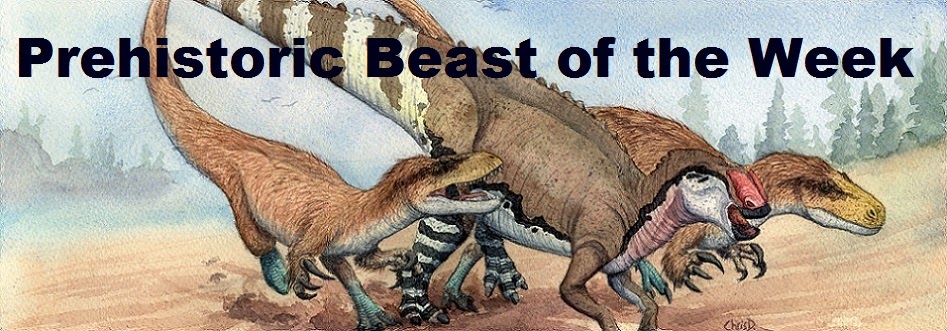This week we will be checking out a dinosaur that gave us insight into its behavior. Make way for Khaan mckennai!
Khaan was a small birdlike dinosaur that lived in what is now Mongolia during the late Cretaceous period, between 75 and 71 million years ago. From beak to tail it measured about four feet (1.2 meters) long and its name means "Lord" in Mongolian. (Doesn't stop dinosaur nerds who are also Star Trek nerds making jokes about it, though.) When alive Khaan was likely an omnivore, eating seeds and plants, but also small animals.
.jpg) |
| Watercolor reconstruction of a female and male Khaan mckenai. There is actual fossil evidence that males of this species may have exhibited courtship dances. (read on) |
Khaan was a member of the oviraptorid family, characterized by their overall very birdlike appearance, with long, slender legs and necks, long arms, tipped with hooked claws, and possessing feathers. They also are known for having unusually blunt skulls with large eye sockets and very short, almost parrot-like beaks. Many of them also had tall bony crests growing from the front of their faces. Khaan was a particularly small example of this group, but many, like Citipati were about human-sized, and others, like Gigantoraptor were huge.
 |
| Skull of Khaan on display at the American Museum of Natural History in New York. |
Like all oviraptorids, Khaan had a short, tall beak, which many experts think was an adaptation for eating mostly plants when alive. Others have suggested it was also eating small animals, and even using their seemingly specialized beak for cracking hard-shelled prey like shelled mollusks and crustaceans. Khaan was actually part of a study that examined the jaws of several kinds of oviraptorids and compared them to those of other kinds of plant-eating theropods, like ornithomimosaurs and therizinosaurs. This confirmed that for their size, oviraptorids had very powerful bites for their size, and may have been using their jaws for crunching through particularly tough plant material that other, weaker-jawed dinosaurs couldn't access.
 |
| Skeletons of the two Khaan specimens that are thought by experts to represent a male and female. They may have even been a pair in life, since they were discovered together. Casts of these skeletons were on display at the American Museum of Natural History in New York for their temporary "Dinosaurs Among Us" exhibit. |
Khaan tells us a lot about dinosaur behavior thanks to a few key details about its anatomy. Two skeletons of Khaan that were adults when they died were discovered right next to each other. Normally there would be no way to tell if these were the same or different sexes, except for the fact that one of them had slightly longer and differently-shaped tail chevrons (bony extensions on vertebrae) which implies there were more muscles there in life. This means one of them was using its tail for something the other wasn't. This had lead to a lot of experts to hypothesize that Khaan may have engaged in courtship dances, like many modern birds do today, like turkeys or grouse, with the males moving their their tails around (probably with feathers on the end) to entice potential partners.
References
Clark, J. M.; Norell, M. A.; Barsbold, R. (2001). "Two new oviraptorids (Theropoda: Oviraptorosauria), Upper Cretaceous Djadokhta Formation, Ukhaa Tolgod, Mongolia". Journal of Vertebrate Paleontology. 21 (2): 209.
Iv, W. S. P.; Funston, G. F.; Currie, P. J.; Norell, M. A. (2015). "A possible instance of sexual dimorphism in the tails of two oviraptorosaur dinosaurs". Scientific Reports. 5: 9472.
Meade, Luke E.; Ma, Waisum (22 February 2022). "Cranial muscle reconstructions quantify adaptation for high bite forces in Oviraptorosauria". Scientific Reports. 12 (1): 3010.
W. Scott Persons IV; Philip J. Currie; Mark A. Norell (2014). "Oviraptorosaur tail forms and functions". Acta Palaeontologica Polonica. 59 (3).

.jpg)
